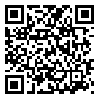Volume 12, Issue 3 (Summer 2024)
PCP 2024, 12(3): 253-262 |
Back to browse issues page
Download citation:
BibTeX | RIS | EndNote | Medlars | ProCite | Reference Manager | RefWorks
Send citation to:



BibTeX | RIS | EndNote | Medlars | ProCite | Reference Manager | RefWorks
Send citation to:
Fallah F, Rezapour-Mirsaleh Y, Behjati F, Hatamian F, Akbari M. The Effectiveness of Neurofeedback on the Behavioral Performance of Children With Social Anxiety Disorder: A Time-series Study. PCP 2024; 12 (3) :253-262
URL: http://jpcp.uswr.ac.ir/article-1-934-en.html
URL: http://jpcp.uswr.ac.ir/article-1-934-en.html
Fatemeh Fallah1 

 , Yasser Rezapour-Mirsaleh *2
, Yasser Rezapour-Mirsaleh *2 

 , Fatemeh Behjati3
, Fatemeh Behjati3 

 , Faezeh Hatamian1
, Faezeh Hatamian1 
 , Maryam Akbari1
, Maryam Akbari1 



 , Yasser Rezapour-Mirsaleh *2
, Yasser Rezapour-Mirsaleh *2 

 , Fatemeh Behjati3
, Fatemeh Behjati3 

 , Faezeh Hatamian1
, Faezeh Hatamian1 
 , Maryam Akbari1
, Maryam Akbari1 

1- Department of Psychology, Faculty of Humanities & Social Sciences, Ardakan University, Ardakan, Iran.
2- Department of Counseling, Faculty of Humanities & Social Sciences, Ardakan University, Ardakan, Iran. ,y.rezapour@ardakan.ac.ir
3- Department of Counseling, Faculty of Humanities & Social Sciences, Ardakan University, Ardakan, Iran.
2- Department of Counseling, Faculty of Humanities & Social Sciences, Ardakan University, Ardakan, Iran. ,
3- Department of Counseling, Faculty of Humanities & Social Sciences, Ardakan University, Ardakan, Iran.
Abstract: (2483 Views)
Objective: Social anxiety is one of the most prevalent issues leading to significant functional and behavioral disorders in children. This study aims to investigate the effectiveness of neurofeedback intervention on the behavioral performance of children with social anxiety disorder (SAD).
Methods: A quasi-experimental study was conducted with a time series design and control group. The statistical population included all 6-8-year old children with SAD (according to the clinical interview and the cut-off score in Leibovitz’s social anxiety questionnaire) referring to the Ziai Counseling Clinic in Meybod City, Iran. A total of 10 children were selected by convenient sampling method and were randomly assigned to experimental and control groups. The experimental group received 16 sessions of neurofeedback intervention, while the control group received no special intervention. Goodman’s abilities and problems questionnaire was used to measure children’s behavioral performance in five phases, pre-test, fourth, eighth, and twelfth sessions of the intervention phase, and post-test. The data were analyzed using analysis of variance (ANOVA) with repeated measurements.
Results: The results showed a significant difference between the mean scores of the experimental group and the control group in behavioral performance; additionally, in the experimental group, a significant difference was observed between the scores of behavioral performances in different phases of measurement, but this difference did not exist in the control group.
Conclusion: The neurofeedback intervention is effective in improving the behavioral performance of children with SAD and can be used as a complementary treatment alongside other psychological and drug treatments for these children.
Methods: A quasi-experimental study was conducted with a time series design and control group. The statistical population included all 6-8-year old children with SAD (according to the clinical interview and the cut-off score in Leibovitz’s social anxiety questionnaire) referring to the Ziai Counseling Clinic in Meybod City, Iran. A total of 10 children were selected by convenient sampling method and were randomly assigned to experimental and control groups. The experimental group received 16 sessions of neurofeedback intervention, while the control group received no special intervention. Goodman’s abilities and problems questionnaire was used to measure children’s behavioral performance in five phases, pre-test, fourth, eighth, and twelfth sessions of the intervention phase, and post-test. The data were analyzed using analysis of variance (ANOVA) with repeated measurements.
Results: The results showed a significant difference between the mean scores of the experimental group and the control group in behavioral performance; additionally, in the experimental group, a significant difference was observed between the scores of behavioral performances in different phases of measurement, but this difference did not exist in the control group.
Conclusion: The neurofeedback intervention is effective in improving the behavioral performance of children with SAD and can be used as a complementary treatment alongside other psychological and drug treatments for these children.
Type of Study: Original Research Article |
Subject:
Approach to biological neural
Received: 2024/04/9 | Accepted: 2024/05/11 | Published: 2024/07/1
Received: 2024/04/9 | Accepted: 2024/05/11 | Published: 2024/07/1
| Rights and permissions | |
 |
This work is licensed under a Creative Commons Attribution-NonCommercial 4.0 International License. |





